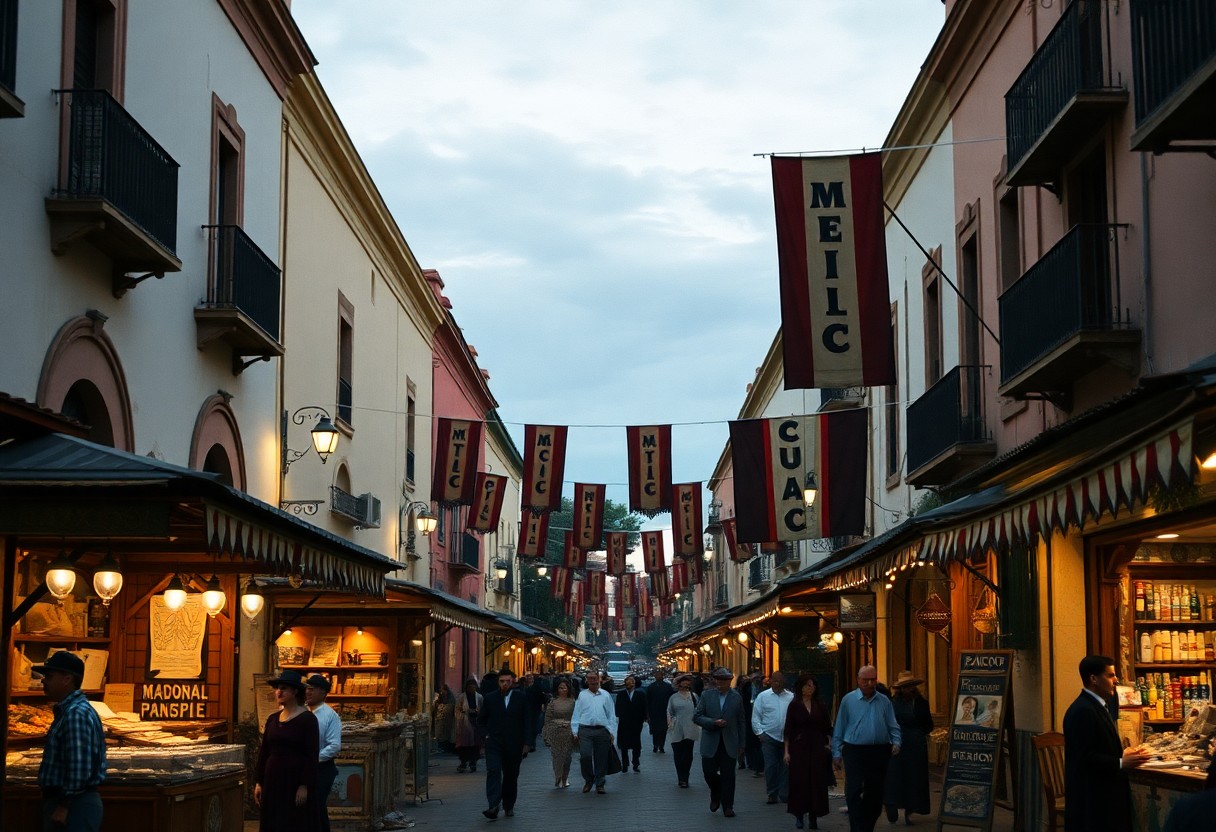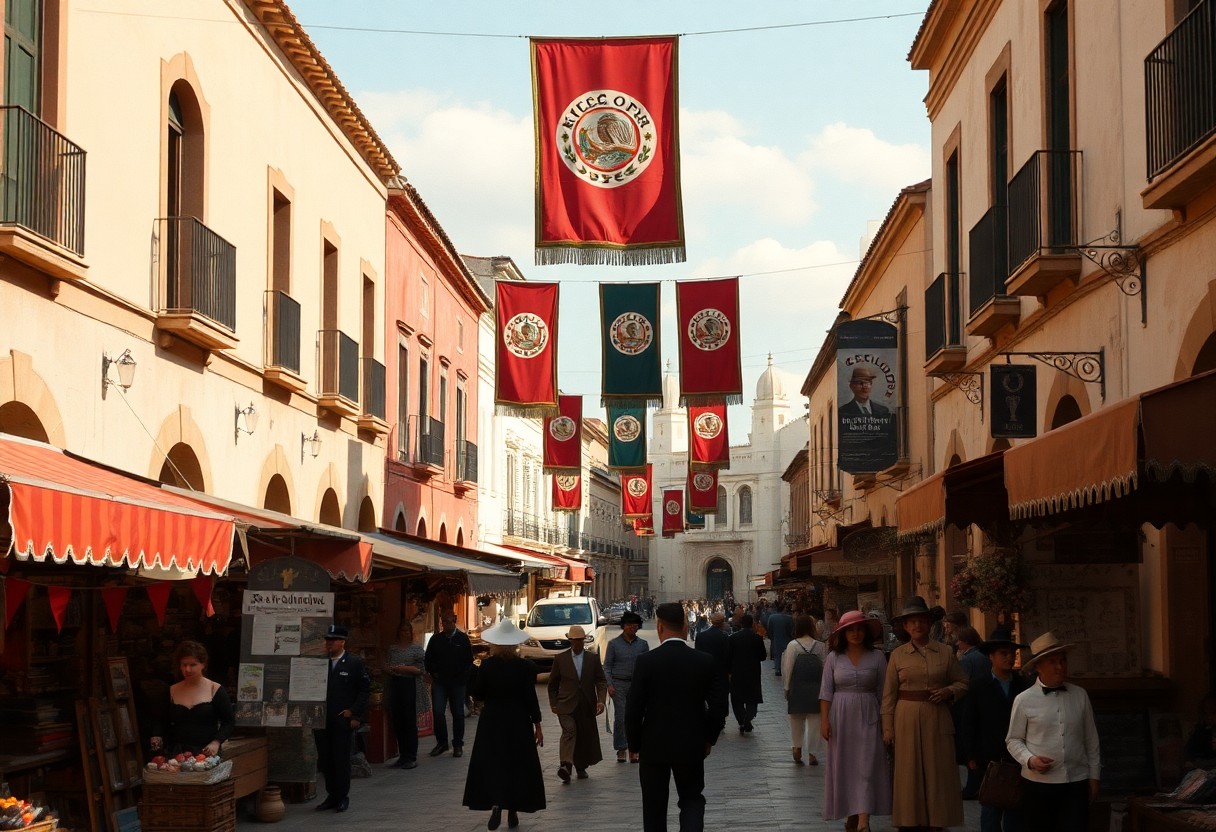Over a century ago, on November 20, 1910, the Mexican Revolution began, profoundly transforming the nation and leaving a lasting impression on cities like <a href=”https://fallinginlovewithsanmiguel.com/considering-leaving-america-explore-san-miguel-de-allendes-charm/”>San Miguel de Allende</a>. This significant uprising emerged from widespread social inequality and oppressive governance, rallying iconic leaders such as Emiliano Zapata and Pancho Villa, who passionately fought for land rights and social justice. Today, the anniversary of November 20th is celebrated with lively parades, historical reenactments, and a deep sense of community pride, particularly in San Miguel de Allende, where the revolutionary spirit is intricately interwoven into the local culture. Discover how this crucial historical event continues to influence life in this vibrant Mexican city.

Uncovering the Historical Roots and Context of the Mexican Revolution
The Mexican Revolution ignited on November 20, 1910, as a direct challenge to the long-standing dictatorship of Porfirio Díaz, whose oppressive rule lasted over three decades, disproportionately benefiting the wealthy elite while leaving the majority of Mexicans in poverty. Initially sparked by a demand for political reform, the movement quickly escalated into a broader struggle addressing severe social and economic inequalities. Throughout the subsequent decade, the revolution transformed the political landscape of Mexico, leading to the establishment of the Constitution of 1917, a foundational legal document that continues to shape Mexican law and governance today.
Examining the Repressive Regime of Porfirio Díaz
Under the regime of Porfirio Díaz, Mexico experienced profound inequality and systemic oppression. Wealth and land were concentrated in the hands of a small, elite class, while the vast majority of Mexicans struggled with poverty and marginalization. Political dissent was brutally suppressed, with elections manipulated to keep Díaz in power. This widespread discontent ignited a fervent revolutionary spirit, as ordinary citizens clamored for fair treatment, significant land reforms, and genuine democratic governance. The fight against Díaz became a powerful symbol of the struggle for justice and equality, resonating deeply within the hearts and minds of the Mexican people.
Francisco I. Madero: The Advocate for Democratic Change
The voice of the revolutionary movement emerged through Francisco I. Madero, a reformist who boldly confronted the autocracy of Díaz. Madero’s influential book, The Presidential Succession of 1910, fervently called for free elections and a definitive end to Díaz's repressive rule. His iconic slogan, “Effective Suffrage, No Re-election,”, resonated with millions of Mexicans who were yearning for change. Madero's leadership sparked the initial uprising, and his election as president in 1911 marked a critical turning point in Mexico’s arduous journey toward democracy. Despite facing numerous challenges, Madero's vision for a fair and just society remains a cornerstone of the revolutionary ideals.
While democracy was central to Madero's ambitions, his presidency was marred by substantial obstacles. Although he made earnest attempts to implement reforms, unifying the various revolutionary factions and maintaining political stability proved to be incredibly difficult. Tragically, his assassination in 1913 at the hands of General Victoriano Huerta’s loyalists represented a devastating setback for the revolutionary cause. Nonetheless, Madero's legacy persisted, as his ideals continued to ignite the ongoing struggle for justice and equality across Mexico.

Honoring the Influential Leaders of the Mexican Revolution
To fully grasp the complexity of the Mexican Revolution, it is essential to recognize the key figures whose leadership significantly influenced the fight for democracy, land reform, and social justice. Francisco I. Madero sparked the revolutionary movement, while Emiliano Zapata rose as a passionate advocate for the rights of peasants. Pancho Villa showcased remarkable military expertise as a commanding leader, and Venustiano Carranza played a pivotal role in crafting the transformative 1917 Constitution. Their collective efforts not only redefined Mexico but also left an enduring impact on San Miguel de Allende, where their legacies are celebrated each November 20th.
Francisco I. Madero: The Visionary Advocate for Democracy
The roots of the revolution can be traced back to Francisco I. Madero, a wealthy landowner who openly opposed Porfirio Díaz’s oppressive regime. Madero’s impassioned call for democracy and fair elections, articulated in his notable book, The Presidential Succession of 1910, inspired millions to join the revolutionary movement. His leadership culminated in Díaz’s ousting in 1911, yet his presidency was tragically short-lived. Madero’s aspiration for a democratic Mexico remains a vital component of the revolution’s enduring ideals, symbolizing the ongoing quest for a more equitable society.
Emiliano Zapata: The Icon of Agrarian Reform
In southern Mexico, Emiliano Zapata emerged as the quintessential figure representing agrarian reform. His powerful slogan, “Tierra y Libertad” (Land and Freedom), resonated profoundly with peasants who had been dispossessed of their lands by wealthy landowners. Zapata’s Plan de Ayala demanded extensive land redistribution, elevating him to the status of a hero among the rural poor. His influence extended far beyond his immediate region, with his ideals still celebrated today in San Miguel de Allende.
At the core of Zapata’s mission was the pursuit of reform. He dedicated himself to restoring land to indigenous communities and small farmers, directly challenging the entrenched power of the elite. Although his assassination in 1919 marked a tragic end to his life, his enduring legacy continues to influence Mexico’s agrarian policies, and he is commemorated annually in San Miguel de Allende.
Pancho Villa: The Charismatic Revolutionary Leader of the North
Shifting our focus to Pancho Villa, the charismatic revolutionary leader from northern Mexico, known for his audacious military strategies and compelling personality. Villa commanded the División del Norte, a formidable army that played a crucial role in defeating federal forces. His victories, particularly during the notable Battle of Zacatecas, were instrumental in shaping the revolution’s direction and outcomes.
Villa distinguished himself through his ability to inspire unwavering loyalty among his troops and his tactical brilliance on the battlefield. While his alliances with other revolutionary leaders were often fraught with tension, his contributions to the revolutionary cause are indisputable. In San Miguel de Allende, Villa’s legacy is celebrated with enthusiasm during the November 20th parades, reflecting the community's profound respect for his role in the revolution.
Venustiano Carranza: The Visionary Architect of the 1917 Constitution
To understand the long-lasting impact of the revolution, one must acknowledge Venustiano Carranza’s crucial role. As a leader, he skillfully united various factions and oversaw the drafting of the groundbreaking 1917 Constitution. This pivotal document introduced progressive reforms, including labor rights, land redistribution, and secular education, fundamentally shaping the future of modern Mexico.
While Zapata and Villa may have embodied the revolutionary spirit, Carranza served as its architect. His leadership ensured that revolutionary ideals were enshrined into law, paving the way for a more equitable society. In San Miguel de Allende, Carranza's influence is commemorated as an essential aspect of the city's rich historical narrative.

Defining Moments that Shaped the Mexican Revolution's Course
Each significant event during the Mexican Revolution played a vital role in shaping the nation’s future. From the overthrow of Porfirio Díaz to the drafting of the Constitution of 1917, these pivotal moments signified major strides toward social and political transformation. They not only altered Mexico's trajectory but also left a lasting imprint on regions like San Miguel de Allende, where the revolutionary ideals continue to resonate within the community.
The Historic Overthrow of Díaz: A Turning Point
Examining the early phases of the revolution, the overthrow of Porfirio Díaz in 1911 stands as a monumental achievement. After decades of authoritarian rule, Díaz's resignation and subsequent exile marked a definitive turning point. This victory for revolutionaries like Francisco I. Madero sparked a wave of hope for democracy and reform throughout Mexico, including in San Miguel de Allende, where the echoes of this accomplishment are still felt today.
Emiliano Zapata and the Zapatista Movement: A Call for Agrarian Rights
Any discussion of the revolution would be incomplete without acknowledging Emiliano Zapata and his relentless campaign for agrarian reform. The Zapatista movement, which flourished in southern Mexico, rallied around the cry of “Tierra y Libertad” (Land and Freedom). This passionate demand for land rights profoundly impacted rural communities and has evolved into a lasting symbol of resistance against oppression.
The events surrounding the Zapatista movement highlighted the deep-seated inequalities entrenched in Mexican society. Zapata’s Plan of Ayala called for widespread land redistribution, directly challenging the power held by wealthy landowners. His legacy continues to inspire movements advocating for social justice, even in places like San Miguel de Allende, where his principles are actively celebrated.
The Pivotal Battle of Celaya: A Defining Conflict
In 1915, the forces of Zapata and Villa faced a significant setback during the Battle of Celaya. This critical conflict, led by Álvaro Obregón, marked a crucial turning point in the revolution. Obregón’s innovative military strategies, including effective trench warfare and the use of machine guns, secured a decisive victory for Carranza’s forces, significantly affecting the momentum of the revolutionary struggle.
The tactics employed during the Battle of Celaya showcased the intricate dynamics within the revolution. Obregón’s military innovations not only weakened Villa’s influence but also paved the way for Carranza’s leadership and the eventual drafting of the essential Constitution of 1917, which would define Mexico’s legal and social framework for generations.
The Groundbreaking Constitution of 1917: A Legal Milestone
The events leading to the creation of the Constitution of 1917 were transformative, introducing a range of progressive reforms such as labor rights, land redistribution, and protections for workers. This historic document laid the essential groundwork for modern Mexico, establishing the legal and social principles that continue to govern the nation today.
A remarkable achievement, the Constitution of 1917 addressed critical issues such as land reform and labor rights, with its effects resonating throughout the country, including in San Miguel de Allende. The constitution reinforced the revolutionary spirit, standing as a testament to the ongoing struggle for justice and equality in Mexican society.
Experiencing the Lively Celebrations of the Revolution
The celebration of November 20th in Mexico is marked by vibrant festivities that honor the profound legacy of the Mexican Revolution. Across the nation, communities participate in parades, reenactments, and cultural events that vividly bring history to life. In San Miguel de Allende, this day holds special significance, with both locals and visitors actively engaging in festivities that highlight the city’s deep-rooted connection to the revolution. From traditional costumes to spirited performances, these celebrations provide a unique opportunity to immerse yourself in Mexico’s rich history and culture.
National Parades and Historical Reenactments: A Living History
The national parades and reenactments stand out as a highlight of the November 20th celebrations. Schoolchildren don costumes representing revolutionary figures such as Emiliano Zapata and Pancho Villa, marching proudly through the streets. Charros, or traditional Mexican cowboys, add an authentic touch to the festivities, while vibrant floats and lively music create a jubilant atmosphere. These events serve not only to entertain but also to educate, ensuring that the sacrifices and achievements of the revolution are remembered and honored.
Distinctive Celebrations in San Miguel de Allende: A Community Affair
One of the most unforgettable ways to experience November 20th is in San Miguel de Allende. The city’s celebrations are deeply interwoven with its revolutionary history, blending cultural pride with a strong sense of community. Attendees can enjoy parades featuring traditional costumes, live music, and captivating performances that narrate the story of the revolution. The streets transform into a lively tapestry of energy, creating an ideal setting for immersing yourself in local customs and traditions.
In San Miguel de Allende, the celebrations take on a unique character. The historic center of the city becomes a bustling hub of activity, where locals and tourists gather to witness the parades and enjoy various festivities. Children dressed as revolutionary figures add a personal and heartfelt touch to the historical reenactments. The atmosphere is both joyous and reflective, as the community takes time to honor the profound impact of the revolution on their lives. Prepare for large crowds and a spirited ambiance, as this day is one of the most anticipated events of the year in the city.
The Lasting Influence of the Revolution on San Miguel de Allende
When examining the historical context, it becomes clear how the Mexican Revolution indelibly shaped San Miguel de Allende. Once a center for the affluent elite, the city transformed into a hub of social reform and cultural revival. The revolutionary ideals of equality and justice fundamentally altered its identity, fostering a sense of community and shared purpose that continues to define the city today.
Significant Social and Cultural Transformations
The social changes initiated by the revolution left a profound impact on San Miguel de Allende. Land reforms empowered local farmers, diminishing the grip of large estates on the community. Culturally, the city embraced its indigenous heritage, merging traditional practices with revolutionary ideals to forge a unique identity. This fusion is evident in the city's vibrant festivals, artistic expressions, and architectural styles, enriching the cultural landscape that visitors can explore today.
The Enduring Legacy of Revolutionary Ideals in San Miguel de Allende
The most enduring impacts of the revolution are reflected in San Miguel de Allende’s steadfast commitment to equality and education. The city emerged as a model for progressive reforms, with schools and community initiatives embodying the revolution’s emphasis on social justice and empowerment. These ideals resonate with both residents and visitors, making the city a living testament to the revolutionary spirit.
The revolutionary ethos exemplified by figures like Miguel Hidalgo continues to thrive in San Miguel de Allende. The city’s land reforms and educational advancements are direct products of the revolution's influence. However, the pursuit of equality has also presented challenges, including periods of conflict and instability. Despite these hurdles, the city has emerged as a symbol of resilience, adeptly merging its revolutionary past with a vibrant present. Today, visitors can witness this legacy in its flourishing arts scene, historic landmarks, and a strong sense of community that honors its roots.
Recognizing the Modern Relevance of the Mexican Revolution
To fully appreciate the significance of the Mexican Revolution, one must understand its roots in contemporary Mexico. The revolution fundamentally reshaped the nation’s political, social, and economic landscapes, laying the groundwork for democracy and social justice. Its legacy continues to influence Mexico’s identity, serving as a powerful reminder of the importance of collective action and the ongoing need to address inequality. In San Miguel de Allende, the impact of the revolution is vividly reflected in its cultural pride and community-driven spirit, making it a living testament to the enduring relevance of this historic event.
Important Lessons in Democracy and Social Justice
Even today, the Mexican Revolution imparts valuable lessons about the significance of democracy and the relentless pursuit of social justice. The revolution's leaders, such as Emiliano Zapata and Francisco Madero, ardently advocated for land reform and political freedom—ideals that remain integral to Mexico's national identity. Their formidable struggles remind us that genuine progress often requires sacrifice and unity, insights that resonate with modern movements advocating for equality and fairness worldwide.
The Revolution’s Lasting Influence on the Modern Mexican Landscape
Today, democracy in Mexico owes much to the legacy of the revolution. The Constitution of 1917, born from the revolutionary struggle, instituted groundbreaking reforms concerning labor rights, land distribution, and education, shaping the contours of modern Mexican society. In San Miguel de Allende, the spirit of the revolution continues to thrive through its vibrant culture and strong sense of community, reflecting the far-reaching effects of this transformative period.
Lessons drawn from the revolution highlight both its positive and challenging aspects. While it catalyzed significant reforms, the decade-long conflict also inflicted immense suffering and loss. The revolution's legacy serves as a poignant reminder that progress often comes at a cost, yet its ideals of justice and equality continue to inspire. In San Miguel de Allende, you can observe how these principles have shaped a city that values its history while embracing modern possibilities.
Appreciating the Significance of November 20th
Through the lens of history, it is evident that November 20th holds profound significance in Mexico, marking the initiation of the Mexican Revolution. This pivotal event not only reshaped the nation’s socio-political landscape but also addressed critical inequalities, and its legacy continues to resonate in San Miguel de Allende today. By delving into the revolution’s origins, key figures, and vibrant celebrations, you gain valuable insights into Mexico's cultural identity and its ongoing journey toward equality. In San Miguel de Allende, the day is celebrated with parades and reenactments, providing a unique opportunity to connect with the city’s rich heritage. Embrace this chance to explore and appreciate the lasting impact of the revolution on this historic community.
Common Questions About the Mexican Revolution
Q: What significance does November 20th hold in San Miguel de Allende?
A: November 20th commemorates the anniversary of the Mexican Revolution, a pivotal milestone in Mexico’s history. In San Miguel de Allende, this day is celebrated with parades, reenactments, and public events that honor the revolution’s enduring legacy. The city comes alive with vibrant displays of traditional costumes, charros, and schoolchildren portraying key revolutionary figures, fostering a deep sense of community and pride.
Q: Who were the pivotal figures in the Mexican Revolution, and how did they impact San Miguel de Allende?
A: The course of the Mexican Revolution was significantly influenced by leaders such as Francisco I. Madero, Emiliano Zapata, Pancho Villa, and Venustiano Carranza. Their dedicated efforts to advance political reform, land rights, and social justice left a lasting legacy across Mexico, including in San Miguel de Allende. The city’s celebrations honor the ideals of these leaders, emphasizing democracy, equality, and a strong community spirit.
Q: How does San Miguel de Allende commemorate the Mexican Revolution on November 20th?
A: San Miguel de Allende celebrates November 20th with vibrant parades, cultural performances, and historical reenactments. The streets of the city are filled with participants dressed in traditional attire, showcasing the revolution’s enduring themes of freedom and justice. Schools and local organizations often organize events aimed at educating residents and visitors about the historical significance of the revolution and its impact on contemporary society.
The Article: November 20th: Understanding the Mexican Revolution and Its Impact on San Miguel de Allende appeared first on https://fallinginlovewithsanmiguel.com/
The Article Mexican Revolution’s Impact on San Miguel de Allende: Nov 20th Insights Was Found On https://limitsofstrategy.com

